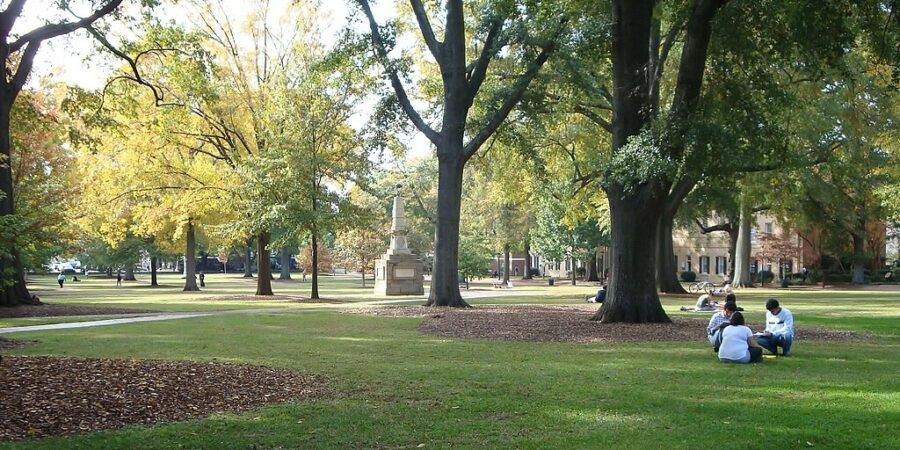By Sam Hyatt and Meg Hultgren, University of South Carolina
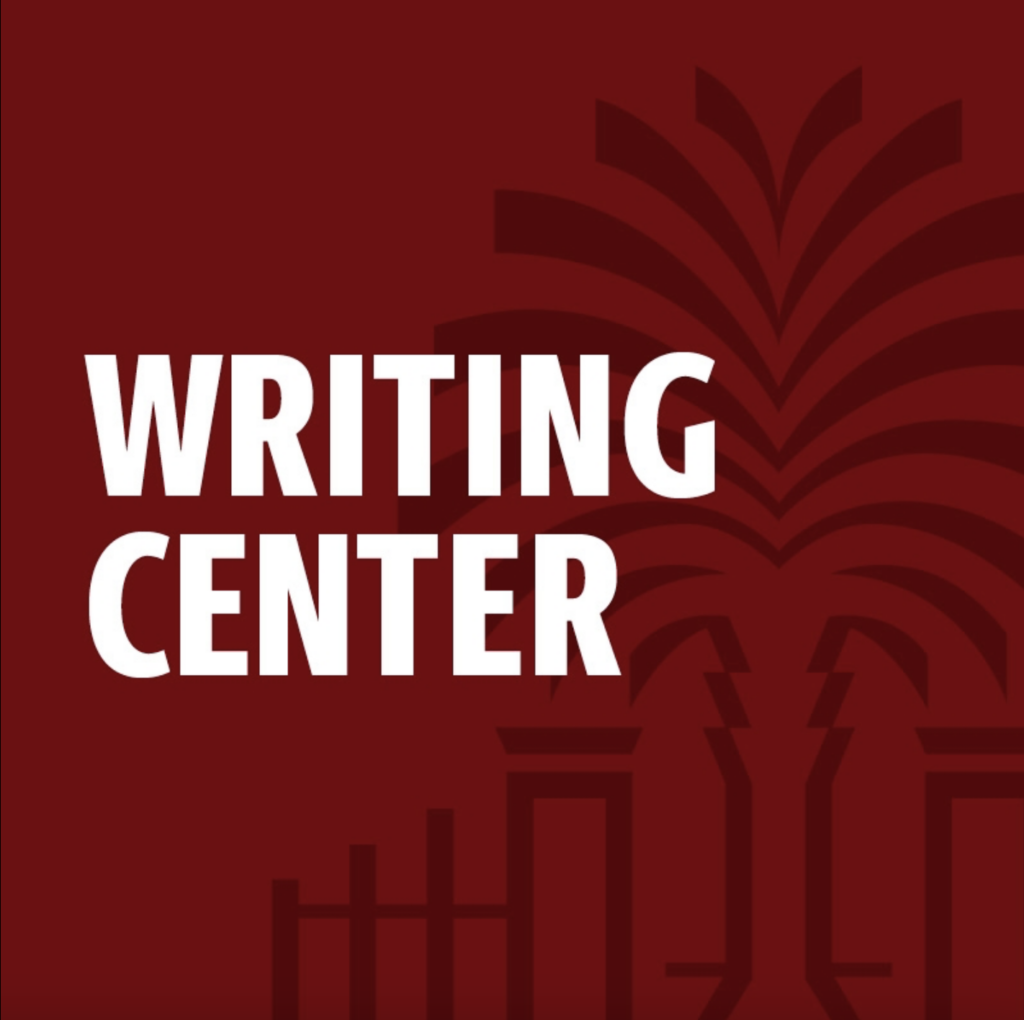
As doctoral students serving as Assistant Directors (ADs) in the Writing Center (WC) at the University of South Carolina during uncertain academic times, we’ve had the unique opportunity to navigate leadership roles while still actively engaged in graduate study. Our tutoring staff is also distinctive—comprised entirely of English graduate students, primarily MAs and MFAs in their first year of school—which has shaped the collaborative and academic culture within our center.
Our overlapping roles as students, tutors, and leaders have been both challenging and rewarding, offering us valuable insights into community-building and professional development in WC work. In this post, we aim to share reflections on our experiences—not only to document our own growth, but also to offer ideas, strategies, and values that may resonate with those in similar positions.
By outlining the ways we’ve worked to foster community in our center, we hope to provide a foundation others can adapt, whether through methodology, shared principles, or new ideas that support ongoing development in writing center leadership and practice.
Introduction
When we were offered positions as the ADs in the WC, we were thrilled to be part of the tutoring world once again as both of us had worked as staff tutors at our previous institutions. We were excited to share our experiences and provide support for growing our tutors’ journeys and abilities, particularly as our 2024–2025 cohort were all entering graduate school for the first time, had limited tutoring experience, and felt concerned about the challenges and isolation that often come with graduate school.
In response, we wanted a huge portion of our job to be geared toward building a positive community that provided stability for these tutors both within and outside of the center. Likewise, from our own experiences, we know that a positive work community not only supports its staff but also lays the foundation for a welcoming and productive environment for clients—in our case, students sharing their writing with us that often has a personal nature.

In our dual roles as fellow graduate students and administrative leaders, it was important to us that we took a ground-up leadership approach. We endeavored to practice rhetorical listening (Ratcliffe 196), open the floor for continuous feedback loops, and encourage productive self-reflection, both by us and the tutors. We aimed to create a space that supported our diverse tutoring staff and also upheld our critical, social-justice driven pedagogy (Newton-Calvert; Baldwin and Smith).
To implement these goals, we began by creating a working definition of community: a dynamic and evolving network of individuals who share connections, support one another, and contribute to a collective sense of belonging. We believe community thrives when its members uplift and empower one another, recognizing the potential collaborative connectivity can have for building positive and sustainable working and learning environments.
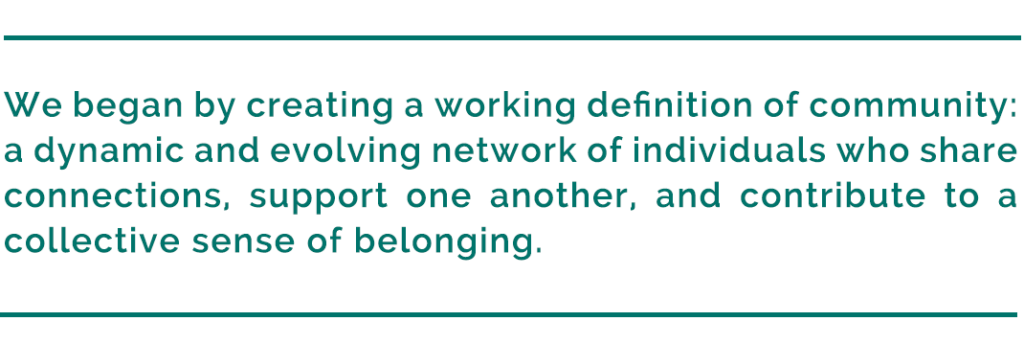
With this definition in mind, we springboarded off some features our director already had in place, such as end-of-semester surveys and reflections. Through these check-ins and periodic assessments, we hoped to create a cohesive and relational atmosphere, finding out where our visions meshed with our tutors’ visions. This strategy allowed us to encourage tutors to participate with real, genuine responses, knowing that they’d receive some sort of acknowledgement and action-based change.
When fully fleshed out, our year-long assessment included tutor surveys, tutor reflections, tutor observations (both peer and WCA conducted), and client feedback reports. Gathering data from multiple angles allowed us to be actively engaged with the tutors, invited conversation, and provided an opportunity for tutors to share their experiences anonymously if they felt it was needed. Additionally, incorporating client perspectives was essential for gaining outside insight into how students perceived the environment and values we aimed to foster within the center. These perspectives also helped us assess whether our internal efforts were translating into productive, impactful tutoring sessions.
Below, we share the first half of our results from our tutor surveys and reflections. Our next step will be to code the data from the tutor observations and client feedback reports as a way to wrap up the 2024–2025 academic year and prepare for our new cohort of tutors in fall 2025.
Tutor Surveys

We distributed two thematic surveys to the tutors to assess key aspects of their experience in the WC. For each survey, we were candid about using the data as an evaluative measure that would help us grow as ADs in serving their needs and the center’s. We were also open about these surveys not being for a grade, that the tutors had the opportunity to fill them out anonymously, and that we may use the data for research and publication purposes. With these acknowledgments, we aimed, and succeeded, in encouraging tutor participation by making it clear that their time and contributions were valued and would be integral in shaping future changes.
The first survey was delivered in the fall and focused on tutors’ session progress and areas of interest for further learning in our tutor education course, which offered them the opportunity to take responsibility and work with the admin team, not just for us. We did this to break down the power structures that are apparent in academia, thus creating a basis for reciprocity, a key aspect of community-building. In turn, this survey asked questions such as: “What conversations (with the WCA team or other tutors) have helped you develop best client centered practices?” “What are your goals as a tutor?” “What are you learning and building on during tutor ed?” and “What conversations would you like to have with the WCA team and others?”
In their responses, tutors’ indicated a desire for more mentorship via observations. They also asked for specific lessons to be incorporated into tutor ed sessions such as tutoring ESL/ELL students, explaining introduction and conclusion paragraphs, working with first-year students, and transferring tutor practices into future teaching.
In the following semester, the second survey was given and evaluated the impact of our community-building efforts that we designed with our director’s help, including regular check-ins, practicum project groups and discussions, transparent leadership conversations, and “snaps” to recognize and celebrate wins. This survey asked questions such as, “What is community to you?” “In what ways do you feel like you have or haven’t built community within the WC?” “How does tutor ed impact your community and learning?” “In what ways do you feel like the WCA team can support you more in building community?” “Has the community you’ve built within the WC extended beyond the work space?” and “Do you feel like the WC space is productive in encouraging/allowing for community?”
In terms of community, tutors shared that, to them, community means friendship, support, advice, shared values and concerns, and a safe space for collaboration. Not only did they find these aspects in our center, but they also found a community that cared for and uplifted one another. They accredited these attributes to tutor education, having in-person shifts in our WC (as we also offer remote tutoring), feedback and structured meetings with one another and our WCA team, and organized social events. These facets made our tutors feel that they were able to form lasting relationships with one another and that their community extended beyond the WC space itself.
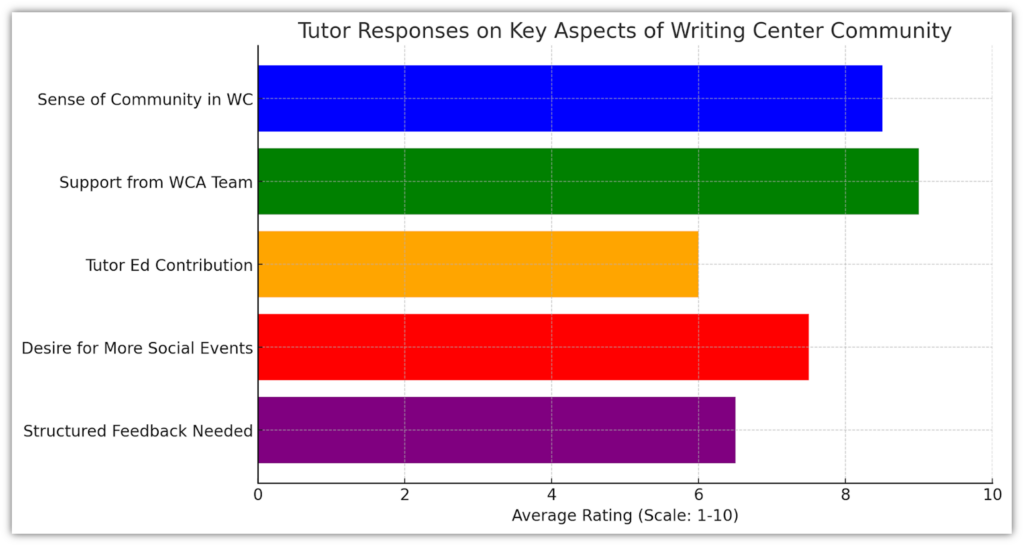
On the whole, the responses to these surveys were indicative of when our practices were working and how they could be improved. The second survey was revealing in terms of what the tutors were actually seeing and doing in their daily activities, whereas the first survey gave us insight to where the tutors needed more support and also facilitated our ability to have more open conversations surrounding their needs.
Reflections
Along with the tutor surveys, we felt it was essential to incorporate reflections as an assessment feature that could provide tutors the opportunity to explore and analyze their positionality as tutors within our WC and think ahead to teaching their own ENGL 101/ENGL 102 courses in their second year. Since most of our tutors did not have previous tutoring experience, we wanted to determine the ways that our WCA team was supporting their growth pedagogically, individually, and collectively. As our director also strongly believes in the effectiveness of reflections, these assignments were easily built into our tutor education schedule.
For these reflections, we asked tutors to share: (a) their initial expectations before beginning tutoring, (b) how their feelings about tutoring evolved since joining our WC, (c) the significance of their interactions with fellow tutors and the WCA team, and (d) their goals for their future tutoring journeys. After receiving the reflections, we thematically coded them and found many tutors explored these prompts through instruction examples, lessons and discussions from our tutor education course, specific interactions, emotional connectivity, and explaining where and when they felt like their tutoring cohort had supported them during their development.
Through these means, tutors overwhelmingly expressed a strong sense of belonging, with many sharing how they were almost immediately able to connect with fellow tutors. They emphasized the supportive environment cultivated by both peers and administrators where informal interactions and collaborative problem-solving during challenging sessions made a meaningful impact.
![pull quote reads, "Together with the WCA team’s groundwork, [tutors] felt like they built a space that was creative, fruitful, and comfortable for themselves and the students they worked with."](https://dept.writing.wisc.edu/blog/wp-content/uploads/2025/05/pull-quote-SHMH3-1024x301.png)
Most tutors also reflected on their growth, describing a shift from initial uncertainty to a growing sense of confidence and purpose. Their mindsets evolved, moving from focusing on immediate struggles to thinking about long-term development as tutors and educators. Many shared how this growth extended beyond tutoring, helping them see themselves more fully as students, leaders, and collaborators. Together with the WCA team’s groundwork, they felt like they built a space that was creative, fruitful, and comfortable for themselves and the students they worked with.
Conclusions
As we reflect on our experiences, we recognize how crucial intentional, community-centered practices are to the health of a writing center. Fortunately, we’ve been given the opportunity to continue as ADs through the 2025-2026 academic year. Our goals for the summer are to plan how to implement the insights we’ve gathered. Right now, we have the following strategies in mind:
- Revise our observation schedule to include sessions in both fall and spring semesters, ensuring consistent support and feedback.
- Integrate small practicum groups into the weekly schedule to give tutors space for collaborative discussion and problem-solving.
- Require a minimum number of in-person hours to encourage more frequent face-to-face interaction.
- Incorporate regular intentional check-ins, either during tutor education sessions or admin hours, to build relational trust and awareness.
- Invite tutors to design and lead workshops or presentations based on their unique skills and interests.
- Host out-of-center social events to create informal moments of connection and decompress together as a staff.
In addition to these initiatives, we’ve shared our findings at several conferences to gather feedback from fellow WC practitioners. Just as we ask our clients for feedback to improve our center, we know that learning from others in the field sharpens and deepens our practices. Some of the most impactful advice we’ve received has been simple but meaningful such as replacing the phrase “safe space” with “brave space,” acknowledging that safety is not guaranteed for all, but bravery in community can be collectively nurtured.
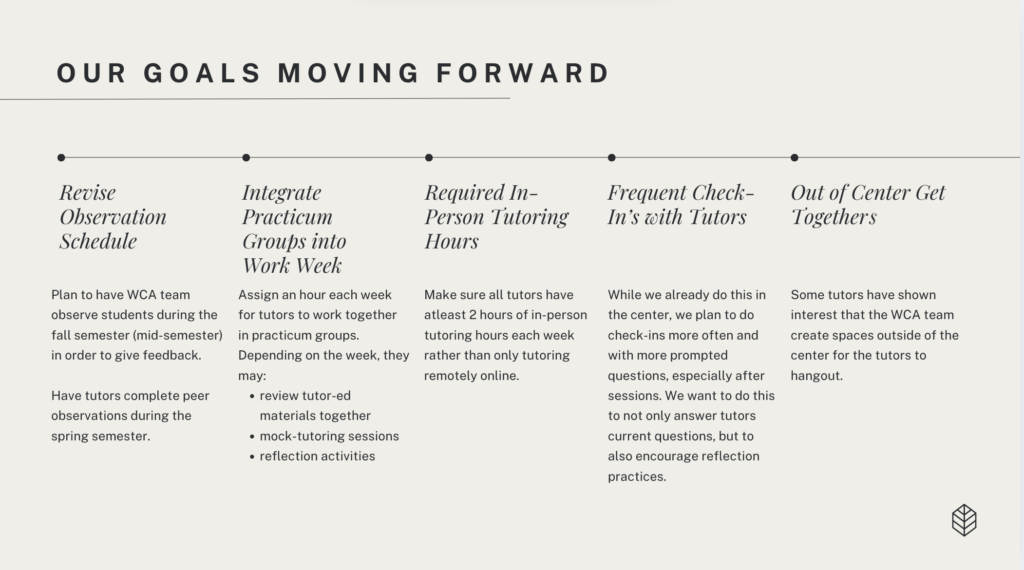
Feedback like this has helped us move toward our social justice goals. We aim to create a center where clients feel empowered to share their writing and where tutors trust and support one another as they grow into educators and leaders. We’ve learned that clear, open communication across all relationships—between administrators and tutors, tutors and clients, and with other WC professionals from various backgrounds and expertise—is at the core of building a truly collaborative space.
Our data collection also revealed the need for more reflective questions and consistent methodologies moving forward. Centering tutor feedback is essential for evolving with our staff and students’ needs. Long-term data collection and increased outreach will continue to be priorities as we assess how community-building influences tutor confidence, session effectiveness, and the broader goals of the writing center.
As we wrap up the semester and say goodbye to our current tutors, we’re still putting these values into practice. We paired tutors for peer observations to prepare them for their upcoming teaching roles and checked in frequently to support them through a busy time. We also planned a lighthearted superlative activity with certificates to help everyone feel seen and celebrated.
Ultimately, creating community in the writing center isn’t about any one initiative. It’s about cultivating a culture grounded in collaboration, listening, reflection, and care. These are the values that make community-building not just possible, but lasting.
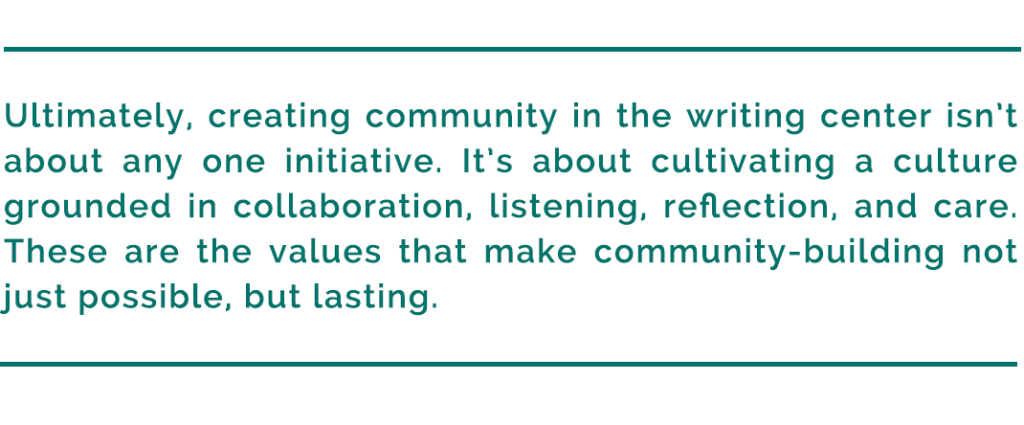
Likewise, these efforts aren’t just relevant to our center. They’re adaptable strategies that other WCs might find useful when considering the populations they work with, tailoring their questions, feedback loops, and social outings to support the needs of their tutors. Each center is different, but something that resonated with us is that assessment is beneficial across all WCs and that continuous work provides consistency as well as much needed change and productivity.
Works Cited
Baldwin, Dianna and Trixie G. Smith. “Stories of Activist Allies in the Writing Center.” Counter Stories From the Writing Center, edited by Wonderful Faison and Frankie Condon, Utah State University Press, 2022, pp. 133–144.
Newton-Calvert, Zapoura. “Rooting Our Teaching in the Change around Us: Growing an Anti-Racist, Community-Interdependent Course Model.” Composition & Rhetoric in Contentious Times, edited by Rachel McCabe and Jennifer Juszkiewicz, Utah State University Press, 2023, pp. 125–142.
Ratcliffe, Krista. “Rhetorical Listening: A Trope for Interpretive Invention and a ‘Code of Cross-Cultural Conduct.’” College Composition and Communication, vol. 51, no. 2, 1999, pp. 195–224. https://doi.org/10.2307/359039.
Sam Hyatt is a third year PhD student at the University of South Carolina where she is pursuing a degree in English with a concentration in Rhetoric and Composition. In addition to teaching First Year English courses, she works as one of the Assistant Directors in her university’s writing center (WC). Currently, her research focuses on inclusive language, or the lack of, in WC documents, in addition to WC pedagogy, and community and storytelling in the WC.
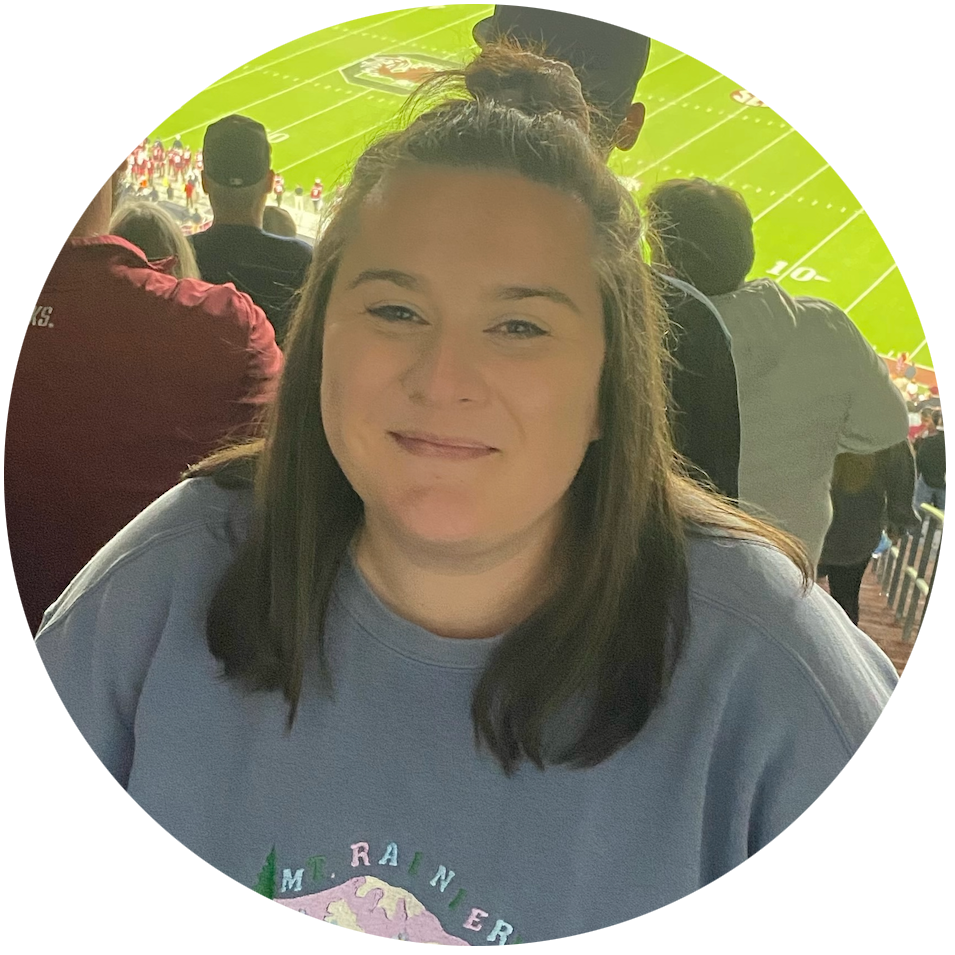
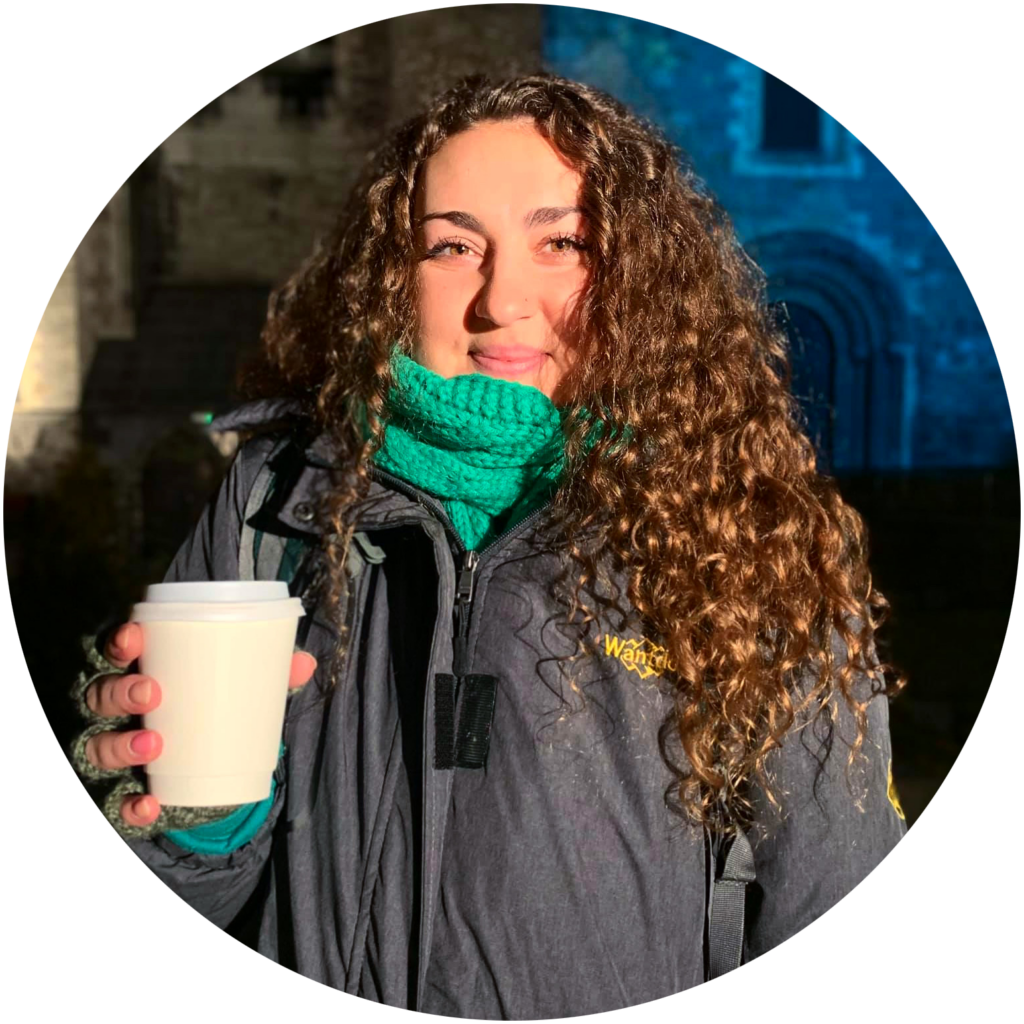
Meg Hultgren is a third year doctoral student at the University of South Carolina studying Composition and Rhetoric. Her background in English Education and Women’s and Gender Studies informs her critical research on language use, rhetorical action and enaction, and community building to challenge linguistic violence in the U.S. Her aim is to continue the work of undoing systemic injustice through understanding and navigating complex terrains with rhetorical intentionality. Her work can be seen in Critical Sexuality Studies, Lavender Languages, and Everyday Life (Bloomsbury, 2024) and in ex æquo 49 (2024).

